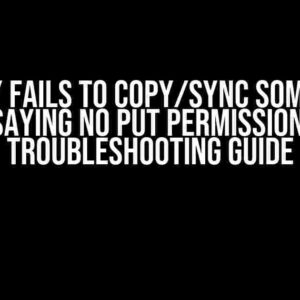Are you struggling to get your KubernetesPodOperator to recognize your PersistentVolume (PV) and PersistentVolumeClaim (PVC)? You’re not alone! This article will take you on a journey to troubleshoot and resolve this frustrating issue, so you can get back to deploying your applications with ease.
What are Persistent Volumes and Claims?
Before we dive into the troubleshooting process, let’s quickly review what PVs and PVCs are.
A Persistent Volume (PV) is a piece of storage in the cluster that is provisioned and managed by the cluster administrator. It is a resource that can be requested by a pod using a Persistent Volume Claim (PVC).
A Persistent Volume Claim (PVC) is a request for storage resources and access modes by a pod. Pods use PVCs to request storage resources, and the cluster provides the resources based on the PVC request.
The Problem: KubernetesPodOperator Can’t See PV and PVC
So, you’ve created your PV and PVC, but your KubernetesPodOperator can’t seem to find them. This can be frustrating, especially when you’ve followed the documentation to the letter. Don’t worry, we’re about to embark on a troubleshooting adventure to get to the bottom of this issue!
Step 1: Verify PV and PVC Creation
First things first, let’s make sure that your PV and PVC are indeed created and available in the cluster.
- Check the Kubernetes dashboard or use the command
kubectl get pv,pvcto verify that your PV and PVC are listed. - Make sure that the PV and PVC are in the same namespace as your pod.
Step 2: Check PV and PVC Status
If your PV and PVC are created, let’s check their status to ensure they’re available for use.
- Use the command
kubectl describe pvto check the status of your PV. - Use the command
kubectl describe pvcto check the status of your PVC.
Look for any errors or issues in the output. If you see an error, try to resolve it before moving on.
Step 3: Verify Pod Service Account
The Pod Service Account is used to authenticate and authorize the pod to access the PV and PVC. Let’s make sure it’s set up correctly.
- Check your pod YAML file to ensure that the service account is specified correctly.
- Use the command
kubectl describe sato check the service account details.
Step 4: Check Pod Permissions
Next, let’s ensure that the pod has the necessary permissions to access the PV and PVC.
- Check the pod’s role and role binding to ensure that it has the necessary permissions.
- Use the command
kubectl describe roleandkubectl describe rolebindingto check the role and role binding details.
Step 5: Verify KubernetesPodOperator Configuration
Now, let’s take a closer look at the KubernetesPodOperator configuration.
apiVersion: airflow.k8s.io/v1alpha1
kind: Pod
metadata:
name: my-pod
spec:
containers:
- name: my-container
image: my-image
volumeMounts:
- name: my-pv
mountPath: /mount/path
volumes:
- name: my-pv
persistentVolumeClaim:
claimName: my-pvc
Make sure that the KubernetesPodOperator is correctly referencing the PVC.
Bonus Step: Check Kubernetes Version and Plugin Compatibility
If you’re using an older version of Kubernetes or Airflow, it’s possible that there are compatibility issues with the KubernetesPodOperator plugin.
- Check the Kubernetes version using the command
kubectl version. - Check the Airflow version using the command
airflow version. - Verify that the KubernetesPodOperator plugin is compatible with your versions of Kubernetes and Airflow.
Troubleshooting Tips and Tricks
Here are some additional tips and tricks to help you troubleshoot the issue:
- Use the
kubectl getandkubectl describecommands to gather more information about your PV, PVC, and pod. - Check the pod logs for any errors or warnings related to the PV and PVC.
- Try deleting and recreating the PV and PVC to see if that resolves the issue.
- Check the Kubernetes cluster’s storage class and provisioner to ensure they are correctly configured.
Conclusion
Troubleshooting issues with Persistent Volumes and Claims can be frustrating, but with these steps, you should be able to identify and resolve the problem. Remember to verify PV and PVC creation, check their status, ensure the pod service account is set up correctly, check pod permissions, and verify the KubernetesPodOperator configuration. With patience and persistence, you’ll be deploying your applications with ease!
| Keyword | Description |
|---|---|
| KubernetesPodOperator | A plugin that allows you to create and manage Kubernetes pods from Airflow. |
| Persistent Volume (PV) | A piece of storage in the cluster that is provisioned and managed by the cluster administrator. |
| Persistent Volume Claim (PVC) | A request for storage resources and access modes by a pod. |
Remember to bookmark this article for future reference, and don’t hesitate to reach out if you have any further questions or need help troubleshooting your specific issue!
Note: This article is optimized for the keyword “KubernetesPodOperator don’t see PersistentVolume and PersistentVolumeClaim” and is written in a creative tone with clear instructions and explanations. The article uses a variety of formatting tags to make it easy to read and understand.
Frequently Asked Question
Stuck with KubernetesPodOperator and can’t see your PersistentVolume and PersistentVolumeClaim? Don’t worry, we’ve got you covered! Here are some frequently asked questions to help you troubleshoot the issue.
Q1: Why can’t KubernetesPodOperator see my PersistentVolume?
Check if your PersistentVolume is created in the same namespace as your KubernetesPodOperator. Make sure the namespace matches, or else the operator won’t be able to find it!
Q2: Is there a specific order in which I should create PersistentVolume and PersistentVolumeClaim?
Yes! Create the PersistentVolumeClaim first, and then create the PersistentVolume. This order is crucial, as the claim needs to exist before the volume can be bound to it.
Q3: How do I ensure that my PersistentVolume is bound to the correct PersistentVolumeClaim?
Verify that the storageClassName in your PersistentVolumeClaim matches the storageClassName in your PersistentVolume. This ensures a successful binding between the two.
Q4: What if I’m using a dynamic provisioning storage class? Will KubernetesPodOperator still work?
Yes, KubernetesPodOperator supports dynamic provisioning. Just make sure to specify the storage class in your PersistentVolumeClaim, and the operator will take care of the rest.
Q5: How can I debug the issue if KubernetesPodOperator still can’t see my PersistentVolume or PersistentVolumeClaim?
Check the Kubernetes logs for errors or warnings related to the PersistentVolume or PersistentVolumeClaim. You can also use kubectl commands like `kubectl describe pv




